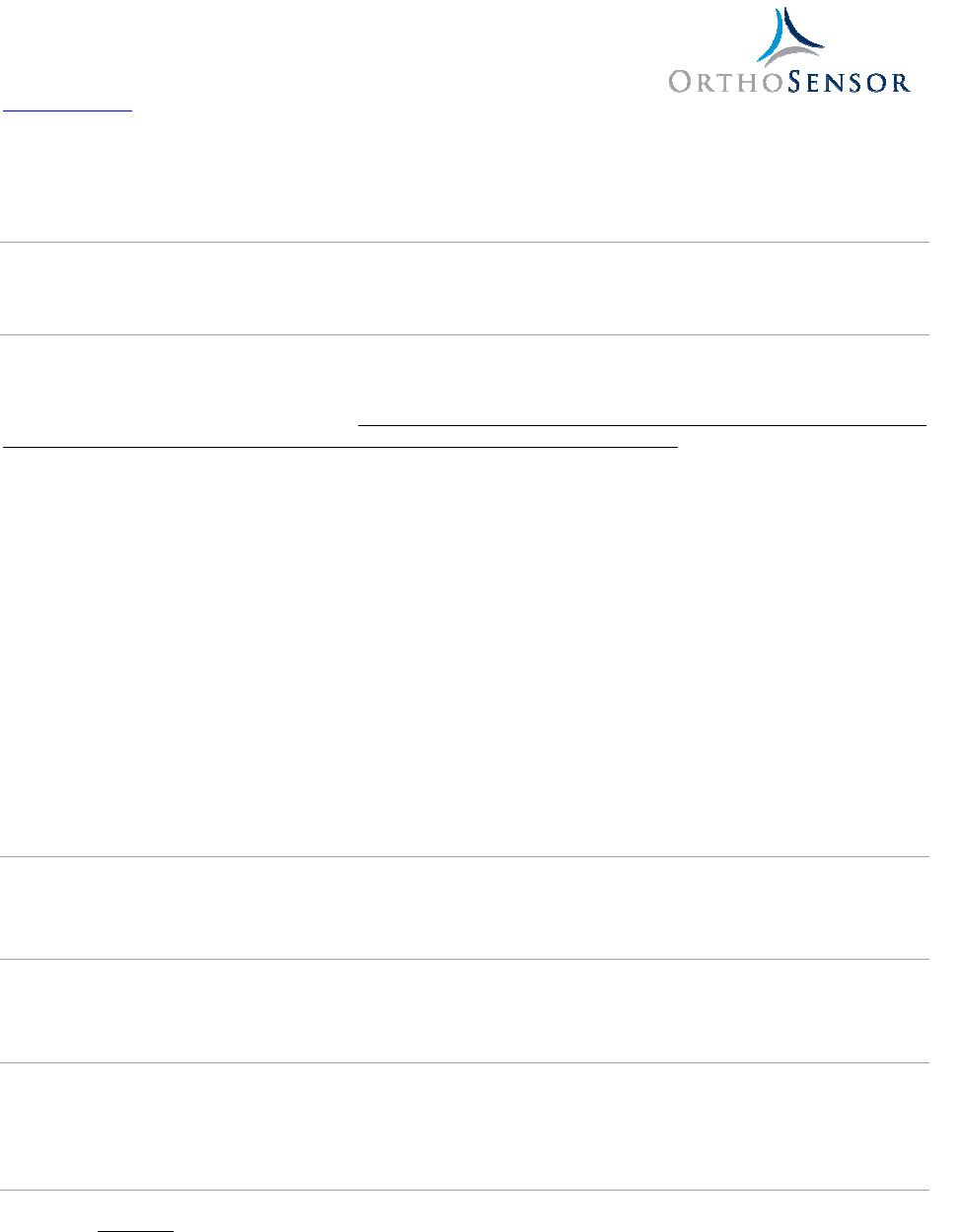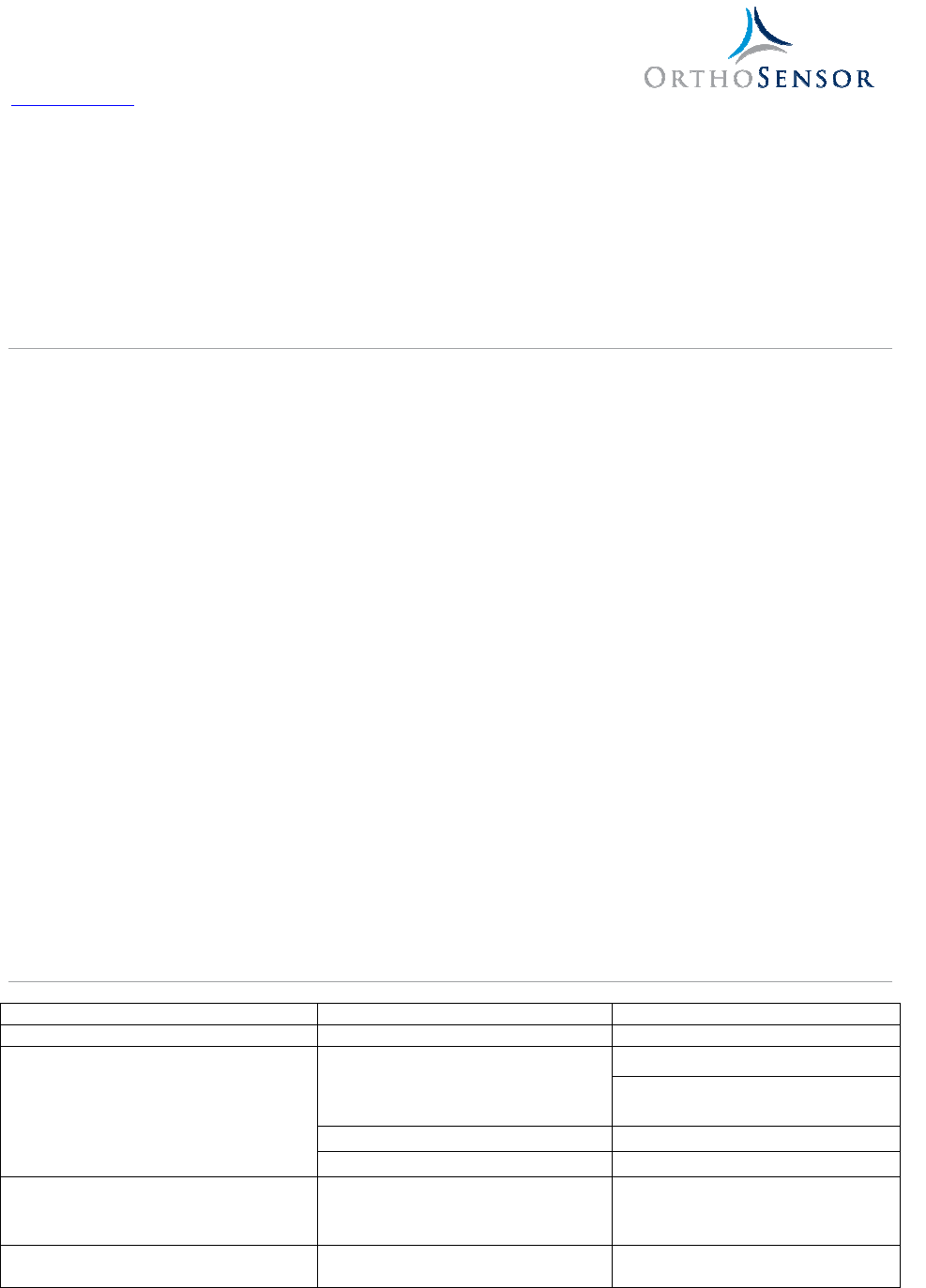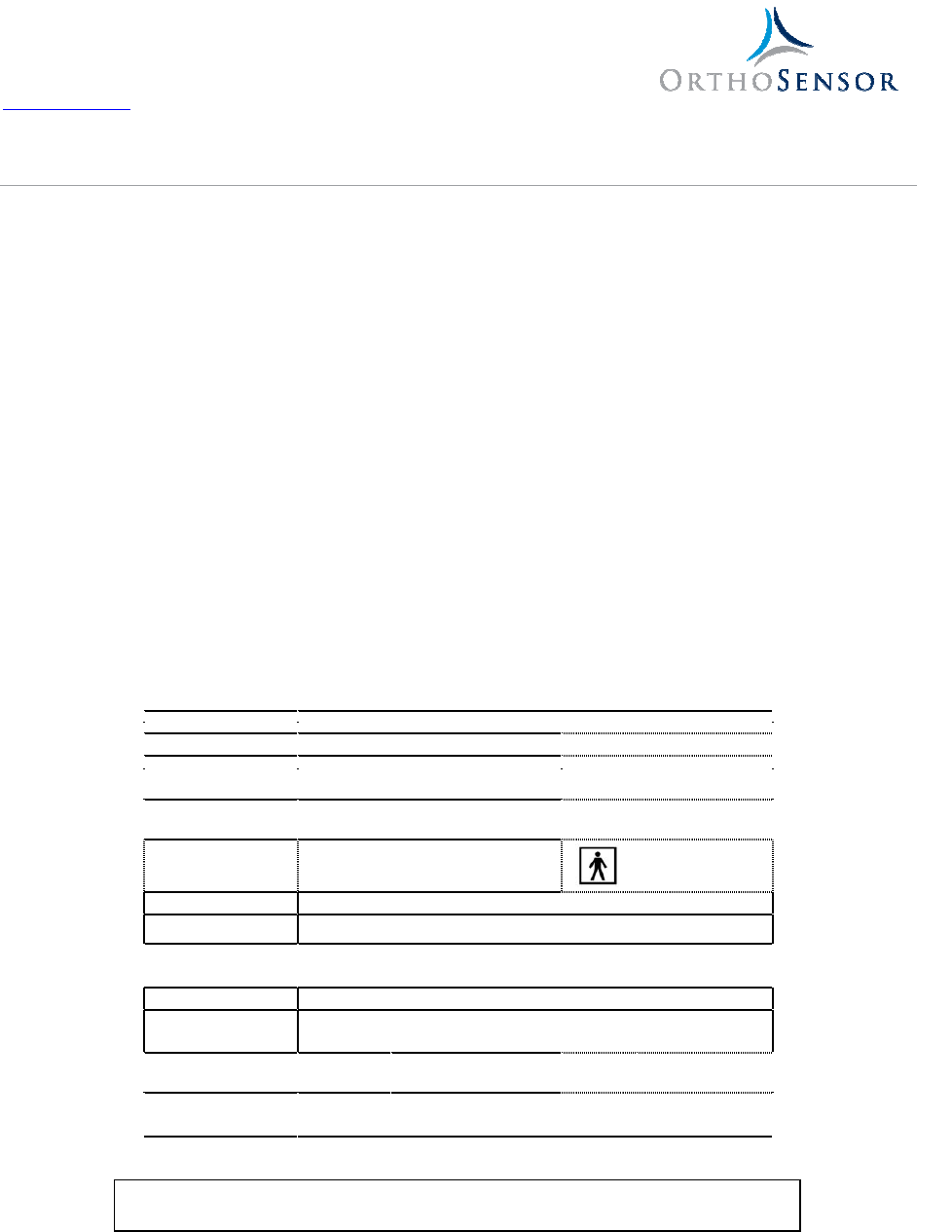Orthosensor ORTHOSNSR1 "Sensor Assisted Surgical" (SAS™) Device User Manual x
Orthosensor, Inc "Sensor Assisted Surgical" (SAS™) Device x
User's Manual Draft

OrthoSensor, Inc
1560 Sawgrass Corporate Pkwy, 4
th
Floor
Sunrise FL, 33326
www.orthosensor.com
07562-X1
TM
ORTHOSENSOR
ORTHOSENSOR ORTHOSENSOR
ORTHOSENSOR LOAD BALANCING SYSTE
LOAD BALANCING SYSTELOAD BALANCING SYSTE
LOAD BALANCING SYSTEM
MM
M
LOAD SENSOR
LOAD SENSOR LOAD SENSOR
LOAD SENSOR INSTRUCTIONS FOR USE
INSTRUCTIONS FOR USEINSTRUCTIONS FOR USE
INSTRUCTIONS FOR USE
DESCRIPTION
DESCRIPTIONDESCRIPTION
DESCRIPTION
The OrthoSensor Load Balancing System (LBS) provides a means to dynamically balance the knee during knee replacement
surgery intra-operatively.
The OrthoSensor Load Sensor (LS) is made exclusively for use with the Stryker Orthopaedics Knee Trial for Triathlon™ system
with special authorization from OrthoSensor. The device is approved for early validation testing only. Therefore, the
information reported by the OrthoSensor System shall not be used to affect patient outcome.
The Load Sensor measures the forces between the tibia and the femur. It wirelessly transmits measured force data to the Link
Station positioned outside the sterile field. The Load Sensor replaces the standard trial tibial insert, it is provided sterile, for
single patient use. A Shim Set is included for thickness adjustments.
Additional Load Balancing System components include:
• Link Station: The Link Station houses a computer and all peripheral equipment required to interpret and display the
force data. The Link Station provides a graphical and numerical presentation of the forces in one or both of the knee
compartments.
• Receiver: The Receiver is incorporated into the Link Station; it receives the wireless transmissions from the Load
Sensor and communicates the data to the computer.
Refer to the OrthoSensor Link Station Instructions for Use for additional details on these components.
INDICATIONS
INDICATIONSINDICATIONS
INDICATIONS
The OrthoSensor Load Balancing System (LBS) is a tool for the adjustment of the femoral knee implant to reduce instability
from flexion gap asymmetry.
CONTRAINDICATIONS
CONTRAINDICATIONSCONTRAINDICATIONS
CONTRAINDICATIONS
• Any active or suspected latent infection in or about the knee joint.
• Refer to Stryker Orthopaedics Triathlon Knee System IFU for additional contraindications.
PRECAUTIONS
PRECAUTIONSPRECAUTIONS
PRECAUTIONS
• Read and follow instructions for proper use and interpretation of force data displayed.
• Strict adherence to the indications, contraindications, precautions and warnings for this product is essential.
• Refer to Stryker Orthopaedics Triathlon Knee System IFU for additional precautions.
USER/PATIENT SAFETY
USER/PATIENT SAFETYUSER/PATIENT SAFETY
USER/PATIENT SAFETY
• The Load Sensor and Shim Set are supplied as single-use sterile devices. If Load Sensor or Shim Set packaging are open or
damaged, do not use and immediately return to OrthoSensor.
• Impact or excessive loading of the Load Sensor may result in a failure of the Load Sensor housing, exposing the patient to
non-sterile and non-biocompatible internal components.
• Load Sensor and Shim Sets are single use only. Do not reuse or resterilze.
• Load range of the Load Sensor is 5 to 40 pounds per condyle.
• Maximum safe allowable load for the OrthoSensor Load Sensor is 70 lbs per condyle.
• Refer to the Device History File for Load Sensor accuracy data.
• Do not load the Load Sensor at its edges.

OrthoSensor, Inc
1560 Sawgrass Corporate Pkwy, 4
th
Floor
Sunrise FL, 33326
www.orthosensor.com
07562-X1
TM
• The Load Sensor contains non-sterile, non-medical grade internal components. If the Load Sensor housing is damaged or
cracked during procedure, take appropriate steps to promote patient safety.
• Do not disassemble the Load Sensor.
• Do not use Load Sensor if it appears not to be functioning properly.
• Observe all warnings and alarms generated by the OrthoSensor Link Station.
• Do not subject Load Sensor or Shims to sudden impact.
• Federal law restricts this device to sale by or on the order of a licensed physician
IN
ININ
INSTRUCT
STRUCTSTRUCT
STRUCTIONS
IONSIONS
IONS
1. Prior to start of procedure, turn Orthosensor Link Station on. Ensure that the station is plugged into a standard 110V
outlet. Then locate the power button, which is located along the left lower rear side of the monitor and press the
button. Upon startup, the system will upload to the main screen.
2. Determine specific size load sensor. Remove pouched shims and load sensor from the box and set atop of the shelf
on the Orthosensor Link Station. DO NOT OPEN POUCH SEALS.
3. Record Load Sensor serial number (S/N) onto patient and hospital records as required.
4. To activate the Load Sensor:
a. Locate the magnet on the right rear side of the retractable keyboard / mouse tray.
b. With the product still in the sealed pouches, place the center rear section of the device over the magnet; a
red light will illuminate; continue to hold in place until the red light turns off.
5. Once the unit is activated, locate the TKA load balancing icon on the screen of the smart system and activate the
software.
6. Upon activation of software scan the label barcode attached to the Load Sensor outer pouch.
7. The software will now enter the active display mode.
8. Open double sealed pouches per hospital protocol (Load Sensor and Shim Set).
9. If required, snap a shim onto the base of the Load Sensor before implanting into the Tibia tray. Shim size to be
determined by the physician.
a. To remove the shim or exchange for another size, simply unsnap the installed shim and replace.
10. The physician should manually compress / apply load to the device and verify it’s response on the Link Station screen
prior to placing Load Sensor into the tibia tray.
11. Confirm that the load sensor module is fully seated when installed onto the tibial tray.
12. Flex the joint throughout its full range of motion five times (5X) to ensure appropriate response on the Link Station.
13. Perform knee surgery with the Load Sensor in conjunction with the instructions displayed on the Link Station, and per
the requirements of the Stryker Orthopaedics Triathlon Knee System. Due to the early verification status of the Load
Sensor do not use the data to affect patient outcome.
a. The load range of the Load Sensor is 5 to 40 pounds per condyle.
b. The maximum safe allowable load for the OrthoSensor Load Sensor is 70 lbs per condyle.
14. Dispose of Load Sensor per institutional guidelines for biohazardous medical waste.
LOAD SENSOR
LOAD SENSOR LOAD SENSOR
LOAD SENSOR (LS)
(LS) (LS)
(LS) TROUBLESHOOTING
TROUBLESHOOTINGTROUBLESHOOTING
TROUBLESHOOTING
Issue
Cause
Solution
Load Sensor (LS) LED does not light up
LS batteries are dead
Discard LS and replace
LS not transmitting data to Link Station
LS is out of wireless range
Move Link Station closer to LS
Move Link Station to achieve an
unobstructed line-of-sight to the LS
LS is powered off
Activate with Link Station magnet
LS batteries are low
Discard LS and replace
LS breakage
LS loaded beyond
limit
LS internal components are non
-
sterile
and non-medical grade. Ensure
patient safety. Discard LS and replace
Lag in reported data
Software latency
Maintain knee position until data
settles (approximately 5 seconds)

OrthoSensor, Inc
1560 Sawgrass Corporate Pkwy, 4
th
Floor
Sunrise FL, 33326
www.orthosensor.com
07562-X1
TM
LOAD SENSOR
LOAD SENSOR LOAD SENSOR
LOAD SENSOR SPECIFICATIONS
SPECIFICATIONSSPECIFICATIONS
SPECIFICATIONS
This device complies with Part 15 of the FCC Rules. Operation is subject to the following two conditions: (1) this device may not
cause harmful interference, and (2) this device must accept any interference received, including interference that may cause
undesired operation.
This equipment has been tested and found to comply with the limits for a Class B digital device, pursuant to part 15 of the FCC
rules. These limits are designed to provide reasonable protection against harmful interference in a hospital installation. This
equipment generates, uses, and can radiate radio frequency energy and, if not installed and used in accordance with the
instructions, may cause harmful interference to radio communications. However, there is no guarantee that interference will
not occur in a particular installation. If this equipment does cause harmful interference, which can be determined by turning
the equipment off and on, the user is encouraged to try to correct the interference by one or more of the following measures:
- Reorient or relocate the receiving antenna
- Increase the separation between the equipment and transmitter.
- Consult OrthoSensor for help.
This device complies with Part 95 of the FCC rules. This device may not interfere with stations operating in the 400.150–
406.000 MHz band in the Meteorological Aids, Meteorological Satellite, and Earth Exploration Satellite Services and must
accept any interference received, including interference that may cause undesired operation.
Modification of this device may void the user’s authority of operate the equipment under the FCC rules above.
Patent Pending
Model:
Load Balancing
System
–
Load Sensor
Quantity:
1
Type:
Single Procedure Only. Do not
resterilize D
Sterile: Ethylene Oxide IQ
Device Type: Type BF
FCC ID:
XNL
-
ORTHOSNSR1
Operating Range: Y6.5 ft [2m] Unobstructed
Mode of
Operation: Temporary (single-use)
Power
Supply:
Internally powered at less than 3.3 VDC
Battery Life
(approximately): 40 minutes
Temperature: Operation 15:l37: Storage 15:l37:
Rx Only
U.S. Federal Law restricts this product to sale by or on the
order of a physician
For
further information, contact the ORTHOSENSOR Customer Service Center by phone at
954
-
577
-
7770
or by e
-
mail
at customerservice@orthosensor.com or go to www.orthosensor.com.